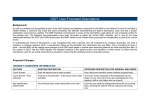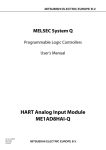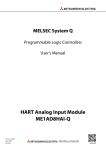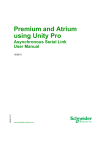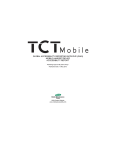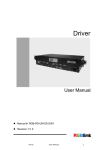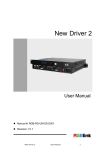Download Operational Matrices for Reporting on Accessibility Features for
Transcript
Operational Matrices for Reporting on Accessibility Features for Telephone Equipment Industry Guideline (G627:2011) These matrices can be used for the purpose specified in G627:2011 MATRIX FOR FIXED LINE HANDSETS Manufacturer/Importer: Product type: Product Brand(s): Model(s) (range/product family): Website and/or contact details for the product: Date completed: (DD/MM/YY) ACCESSIBILITY FEATURE REQUIREMENTS - DESCRIPTION VALUE Handset/Hardware Information Are individual keys easily discernible to the user Give examples – e.g. Key identification phone where all keys are touch-sensitive keypad should say ‘NO’. phone with some keys easily discernible, but not all keys easily discernible, should say ‘NO’. Yes / No ACCESSIBILITY FEATURE REQUIREMENTS - DESCRIPTION VALUE What is the distance from the centre point of one number key to another Key centre point distance _____ mm Horizontal distance between key centres may be different o vertical distance between key centres. The answer “?mm” to be given here should be the smaller of the two measurements. Distance between keys What is the distance between the edge of one number key to another Caller ID screen Screen is caller ID capable _____ mm Yes / No Mobility/Dexterity features Handset weight Handset weight including battery Easy Battery Placement Is battery clearly marked for proper orientation and placement The phone can be mounted on a wall Wall mounting capable Can add if wall mounting directly to a standard Telstra wall mount plate. ……………grams Yes / No Yes / No If ‘Yes’, is the accessory to mount the phone included Yes / No Dial-out buffer memory Number to be called can be entered and checked on the display before sending Yes / No Keypad separate from handset Keypad provided is separate from handset on a base unit or on a plug-in option Yes / No Hands free operation during dialling and after call initiated Yes / No If ‘Yes’ does the phone have full duplex speaker phone capability Yes / No Guarded/recessed keys Individual keys are recessed or guarded in some way to reduce the chance that you will press the wrong key Yes / No Short Messaging Service (SMS) capable Messages can be read, composed and sent using the phone's screen and or keypad Yes / No Speaker-phone capable ACCESSIBILITY FEATURE REQUIREMENTS - DESCRIPTION VALUE Predictive text sending Phone predicts a whole word from the first few letters of the word being typed using an inbuilt dictionary (for SMS/MMS use) Yes / No Phone provides an audible alert when handset not replaced correctly Yes / No Phone provides a visual alert when handset not replaced correctly Yes / No Handset alert Alternative headset can be connected in lieu of handset Handset - connection What is the difference between this question and the question immediately below? Can the handset be disconnected and replaced with a headset What is the difference between this question and the question immediately above? Port for additional earphone/headset This facility enables an additional earphone to be plugged in so both ears can be used to listen or another person can listen and assist with a call. It also enables a headset to be installed for hands-free use. Yes / No Yes / No Yes / No To allow people to use computers as text terminals. Also allows customised devices to work with the phone. Device can be connected to the phone by using: Coupling to a device cable (an electrical wire) Yes / No infrared signal (which travels through the air like a radio wave but cannot pass through walls or other solid objects) Yes / No Bluetooth/wireless LAN (radio signals which travel through the air and may also be able to pass through walls or other solid objects) Yes / No other connections than those described above (please describe): … … … … … … Yes / No Vision features Standard key number layouts The number keys are laid out in the standard way with 1 2 3 at the top and * 0 # at the bottom Yes / No Key feedback - tactile When you press a key you can feel a physical click, so you know it has been pressed Yes / No Key feedback - audible When you press a key it makes a sound, so you know it has been pressed Yes / No ACCESSIBILITY FEATURE REQUIREMENTS - DESCRIPTION VALUE Audible identification of keys spoken When you press a number key the number is spoken out, so you know you have pressed the correct one Yes / No Audible identification of keys function The sounds you hear when you press a key are different for number keys and function keys, so you can easily tell them apart Yes / No Adjustable font - style You can change the font (typeface) used for the text on the display, which may make it easier to read Yes / No Adjustable font - size You can make the text on the display larger or smaller to make it easier to read Display characteristics - Adjustable Contrast Control You can adjust the contrast of the display to make text and symbols easier to see against the background Yes / No Display characteristics - Adjustable Brightness Control You can adjust the brightness of the display to make it easier to read Yes / No Display characteristics - Main Display Size Size of the main display Display characteristics - Backlight for Display The display lights up to make it easier to read in the dark Yes / No Display characteristics - Colour Differentiation The information presented on the display does not rely on colour perception for understanding (e.g. you do not have to be able to distinguish red symbols from green symbols) Yes / No Voice output of Caller ID - inbuilt Can read text messages out loud to you Yes/ No Key feedback - displayed Number being dialled is displayed on the screen Yes / No Ringer volume adjustable Adjustment of the ringing volume is possible Yes / No Ringer volume loudness Extra loud capability or special purpose capability Yes / No ___ X ___ mm Hearing features ACCESSIBILITY FEATURE REQUIREMENTS - DESCRIPTION VALUE Visual display of incoming text is provided This needs clarification: – Is SMS considered to be “incoming text”? Text display - visual – Is a modem device capable of transmitting/Receiving modem standards such as (say) V21 300Bits/S considered to be “incoming text”? Yes / No – Is CND considered to be “incoming text”? – Is TTY considered to be “incoming text”? – yes of course (I think), but should the TTY standards be specified that the TTY is capable of? (e.g. Baudot 50 Baud, V18 etc). Tactile ringing signal Vibrating indication is provided when the phone rings Yes / No Vibrating alert Compatible with a separate vibrating alert facility Yes / No Light source is provided to indicate when the phone rings This needs clarification: Is this question referring only to a large light-emitting source (e.g. a set of bright LEDs on the phone that light up brightly when the phone rings)? Visual ringing signal Or is this question referring to any visual ring indication, such as: A small LCD icon flashing on a cordless phone handset display? A small LCD icon flashing on a cordless phone handset display, combined with the Handset/Display backlight turning on? A small, single flashing LED on the Base Unit of a cordless phone? etc Yes / No ACCESSIBILITY FEATURE REQUIREMENTS - DESCRIPTION VALUE Visual display of the line status (i.e. on-line) This needs clarification: Visual line status display Is this question asking if a particular telephone device can give the user a visual signal that that particular device itself is currently using the phone line? For example, multiple-handset DECT cordless phones often show a small icon LCD symbol on ALL of the DECT Handsets in the group, to indicate that one handset is using the phone line. Or is this question referring to a feature whereby the telephone device can detect that another completely separate device (e.g. a fax, or modem, or cordless telephone etc) is currently using the telephone line? Adjustable volume control of microphone to amplify outgoing speech Microphone amplification Yes / No Should we specify TX volume in dB above ACMA nominal SLR?? Setting ‘Retains’ or ‘Resets’ to default after each call Yes / No Retains / Resets 2.5 / 3.5 / USB / Modular style plug / proprietary / No Headset – plug type The type of plug a headset will need to have so that it can be connected to the phone Hearing aid compatibility When used with a hearing aid set to the ‘T’ position, the sound is clearer Yes / No Ring tone variations Possibility to assign different ring tones to different stored numbers Yes / No Ring tone selection Select alternate ring tones Yes / No Able to download ring tone Should this be re-worded to ask if the user can program their own Ring Tone into the phone (sourcing the Ring Tone from anywhere they like, including download from the internet) Yes / No Adjustable volume control of receiver voice volume Yes / No Setting ‘Retains’ or ‘Resets’ to default after each call Retains / Resets Receiver voice volume ACCESSIBILITY FEATURE REQUIREMENTS - DESCRIPTION VALUE If values are available, what are the maximum and minimum receiver volume levels This needs clarification: Is the min/max that should be specified here referring to dB above/below ACMA nominal RLR?? Adjustable receive audio tone control ADDITIONAL FEATURES & CHARACTERISTICS OPTIONAL FEATURES & ACCESSORIES ……………dB (min) ……………dB (max) Yes / No MATRIX FOR MOBILE HANDSETS Where an accessibility feature has further technical information for suppliers, the information is provided as notes at the end of the ‘Matrix for mobile handsets’ table. Manufacturer/Importer: Product Brand(s): Model(s) (range/product family): Website and/or contact details for the product: ACCESSIBILITY FEATURE Date completed: (DD/MM/YY) REQUIREMENTS - DESCRIPTION VALUE Does the device have a touch screen (Note 1) Yes / No If the device has a touchscreen, is it capacitive (sometimes referred to as heat activated) (Note 2) Yes / No Are individual keys easily discernible to the user Yes / No Handset/Hardware information Touch screen Key identification How are the keys discernible - separate keys, use of ridges to define (Note 3) What is the distance from the centre point of one number key to another Key centre point distance _____ mm ACCESSIBILITY FEATURE REQUIREMENTS - DESCRIPTION VALUE Keyboard layout The keypad is laid out like a QWERTY typewriter keyboard Yes / No Lanyard pin for key ring or lanyard strap Has a small bar allowing a key ring or neck strap (lanyard) to be attached Yes / No Differentiation of function keys The number keys have a different colour or shape from the other keys, making them easier to tell apart by touch or by sight Yes / No A. Clam Shell / Flip Phone B. Candy Bar / Stick C. Slide Shape of device D. Swivel A, B, C, D, E, F or G E. Touchscreen F. Smart Phone G. Other Operating system The operating system and version used by this phone (Note 4) Anti-slip features Has a non-slip coating or ridges to prevent it slipping out of your hand System and version Yes / No Mobility/Dexterity features Handset weight Handset weight including battery (Note 5) Easy Battery Placement Is battery clearly marked for proper orientation and placement Yes / No Speaker-phone capable Hands free operation during dialling and after call initiated Yes / No Guarded/recessed keys Individual keys are recessed or guarded in some way to reduce the chance that you will press the wrong key Yes / No Coupling to a device ……………grams To allow people to use computers as text terminals. Also allows customised devices to work with the phone. Device can be connected to the phone by using: cable (an electrical wire) Yes / No ACCESSIBILITY FEATURE REQUIREMENTS - DESCRIPTION VALUE infrared signal (which travels through the air like a radio wave but cannot pass through walls or other solid objects) Yes / No Bluetooth/wireless LAN (radio signals which travel through the air and may also be able to pass through walls or other solid objects) Yes / No other connections than those described above (please describe): … … … … … … Yes / No Flat back for table top operation Has a flat back, so it can be used while it is lying on a table Yes / No Any key answering The user can answer the call by pressing any key Yes / No Hand movement Some controls require you to pinch or twist them with your fingers, or rotate your wrist Yes / No Voice recognition for dialling Allows you to dial a number by speaking the person’s name, if it is stored in your contact list (a personal ‘telephone book’ you create in your phone) Yes / No Voice recognition for accessing features Allows you to activate features by speaking commands into the phone, reducing the need to use the keypad Yes / No Automatic answering Enables the phone to pick up a call automatically after a designated number of rings Yes / No Tactile key markers – ‘5’ The number ‘5’ key has a raised dot or bump on it so you can distinguish it by touch (required for all Customer Equipment sold in Australia) Yes / No Tactile key markers – ‘F’ and ‘J’ The 'F' and 'J' keys have raised dots or bumps on them so you can distinguish them by touch (only relevant for phones that have a QWERTY typewriter-style keypad) Yes / No Standard number key layouts The number keys are laid out in the standard way with 1 2 3 at the top and * 0 # at the bottom Yes / No Key feedback - tactile When you press a key you can feel a physical click, so you know it has been pressed Yes / No Key feedback - audible When you press a key it makes a sound, so you know it has been pressed Yes / No Audible identification of keys spoken When you press a number key the number is spoken out, so you know you have pressed the correct one Yes / No Vision features ACCESSIBILITY FEATURE REQUIREMENTS - DESCRIPTION VALUE Audible identification of keys functions The sounds you hear when you press a key are different for number keys and function keys, so you can easily tell them apart Yes / No Adjustable font - style You can change the font (typeface) used for the text on the display, which may make it easier to read Yes/ No Adjustable font - size You can make the text on the display larger or smaller to make it easier to read Yes/ No Personalised shortcuts You can assign a particular feature to a single key or a short key sequence Yes/ No Display characteristics - Adjustable Contrast Control You can adjust the contrast of the display to make text and symbols easier to see against the background Yes / No Display characteristics - Adjustable Brightness Control You can adjust the brightness of the display to make it easier to read Yes / No Display characteristics - Main Display Size Size of the main display Display characteristics - Main Display Resolution The number of dots (called pixels) used to display text and images on the main display. More dots mean more detail. ___ X ___ Display characteristics - Backlight for Display The display lights up to make it easier to read in the dark Yes / No Display characteristics - Colour Differentiation The information presented on the display does not rely on colour perception for understanding (e.g. you do not have to be able to distinguish red symbols from green symbols) Yes / No Display characteristics Symbols/Icons Menus can be displayed using symbols or pictures in a grid layout. This can make them easier for some people to understand or remember Yes / No Display characteristics - Screen Flicker The main display does not flicker at a rate that could cause problems for people with photo-epilepsy (between 2 Hz and 60 Hz) Yes / No Voice output of caller ID from contacts list When you receive a call, it speaks the caller’s name if it is stored in your contact Yes / No Voice output of SMS: inbuilt Can read text messages out loud to you Yes/ No ___ X ___ mm ACCESSIBILITY FEATURE REQUIREMENTS - DESCRIPTION VALUE Voiced menus Speaks the menu options, allowing you to access functions even if you cannot read the display Yes/ No Ring tone variations You can set it to use different ring tones for different people when they call you (Note 6) Yes / No Alternative format user manual The user manual is available in alternative formats such as accessible online (Note 7) Yes / No Vibrating alert The phone can be set to vibrate when it receives a call or text message or when it gives a warning alert Yes / No Visual alerts - Incoming calls When a call or text message comes in, it displays a visual alert, such as the caller’s name or photo if it is stored in your contact list Yes / No Two-way video communications – using mobile networks Allows you to make video calls in which you can see the other person and they can see you using your mobile network Yes / No Two-way video communications – using wireless LAN networks Allows you to make video calls in which you can see the other person and they can see you using your wireless LAN network Yes / No Headset – plug type The type of plug a headset will need to have so that it can be connected to the phone (Note 8) Hearing aid compatibility When used with a hearing aid set to the ‘T’ position, the sound is clearer Yes / No Messaging Options - MMS Allows you to send and receive multimedia messages, which can include photographs, audio and video clips Yes / No SMS personalisation and reuse Allows you to create standard text messages that you can quickly send to anyone without having to retype them each time. For example, “I’m in a meeting, I’ll call you back” Yes / No Messaging options - Email Allows you to send and receive email messages Yes / No Internet capability You can use the phone to browse websites and use other internet-based services (Note 9) Yes / No Hearing Features 2.5 / 3.5 / USB / proprietary / No ACCESSIBILITY FEATURE REQUIREMENTS - DESCRIPTION VALUE ADDITIONAL FEATURES & CHARACTERISTICS OPTIONAL FEATURES & ACCESSORIES Technical notes for suppliers: 1 Touch Screen: Does the device have either a resistive or capacitive touchscreen. 2 Touch Screen: If the device has either a resistive or capacitive touchscreen, state whether the touchscreen is capacitive. 3 Key Identification: If the individual keys are easily discernible to the user, state how the keys are discernible to the user - either through the use of: (1) separate keys; (2) use of ridges to define; or (3) other. 4 Operating System: State the operating system installed in the product. 5 Handset weight: State the weight of the handset with the battery in place in the unit. 6 Ring Tone Variations: Can the user assign specific ring tones to different stored numbers. 7 Alternative format User Manual: State whether the User Manual is available in alternative formats. 8 Headset - plug type: If the phone has a physical connection for a handsfree headset (of any kind), state whether the device has a 2.5mm, 3.5mm, USB or proprietary connection. 9 Internet Capability: Is the device capable of accessing the internet.













